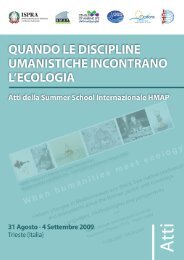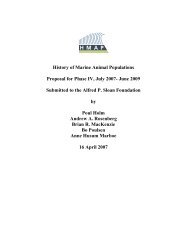The Danish fisheries c.1450-1800. Medieval and early modern ...
The Danish fisheries c.1450-1800. Medieval and early modern ...
The Danish fisheries c.1450-1800. Medieval and early modern ...
Create successful ePaper yourself
Turn your PDF publications into a flip-book with our unique Google optimized e-Paper software.
towns like Copenhagen, Malmø <strong>and</strong> Helsingør where they would still find a local market for<br />
their products. 29<br />
- Consumption<br />
Many factors may explain the relative price decline. After the Protestant reformation,<br />
‘catholic practices’ such as the eating of fish at stipulated times were given up. When fasting<br />
regulations were abolished, the wealthy turned to a meat diet even on traditional ‘fish days’.<br />
North West European consumption habits gave greater priority to meat <strong>and</strong> poultry; declining<br />
fish consumption was evident in Britain <strong>and</strong> the Sc<strong>and</strong>inavian countries by the seventeenth<br />
century. This is a general factor which helps to explain the development of North Atlantic<br />
<strong>fisheries</strong>. Of course, dem<strong>and</strong> remained for the provision of cheap protein for the labouring<br />
poor, especially the exp<strong>and</strong>ing numbers of seafarers who needed nutritious <strong>and</strong> well-<br />
preserved food for long voyages, but the dem<strong>and</strong> for well-preserved, high-quality fish<br />
contracted. 30<br />
Unfortunately, practically no work has been done on <strong>Danish</strong> food consumption<br />
patterns in the sixteenth <strong>and</strong> seventeenth centuries; the change in diet probably did not follow<br />
immediately upon the Reformation but rather occurred during the first half of the seventeenth<br />
century. 31 Fish consumption in rural areas probably changed more slowly than in the towns<br />
<strong>and</strong> among the nobility. By the middle of the eighteenth century, the y<strong>early</strong> ration of herring<br />
for a Zeal<strong>and</strong> agricultural worker was reckoned as one quarter of a barrel; 32 this ration need<br />
not have changed much since the Middle Ages.<br />
29 Stoklund 1959, 119.<br />
30 Heckscher; Cutting; Grøn.<br />
31 Lilli Friis, ‘Æde og drikke’, 419-23. <strong>The</strong>re is a rich source material in estate food lists.<br />
32 Heckscher 1949, xxv (note referring to p. 285).






